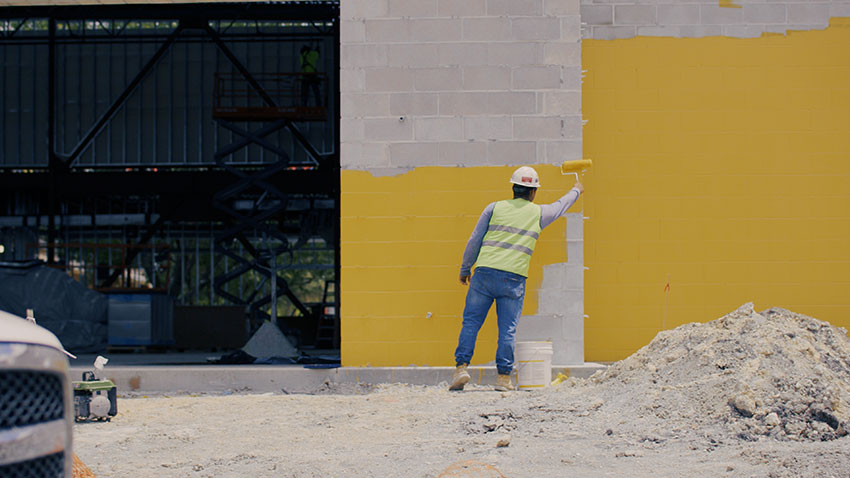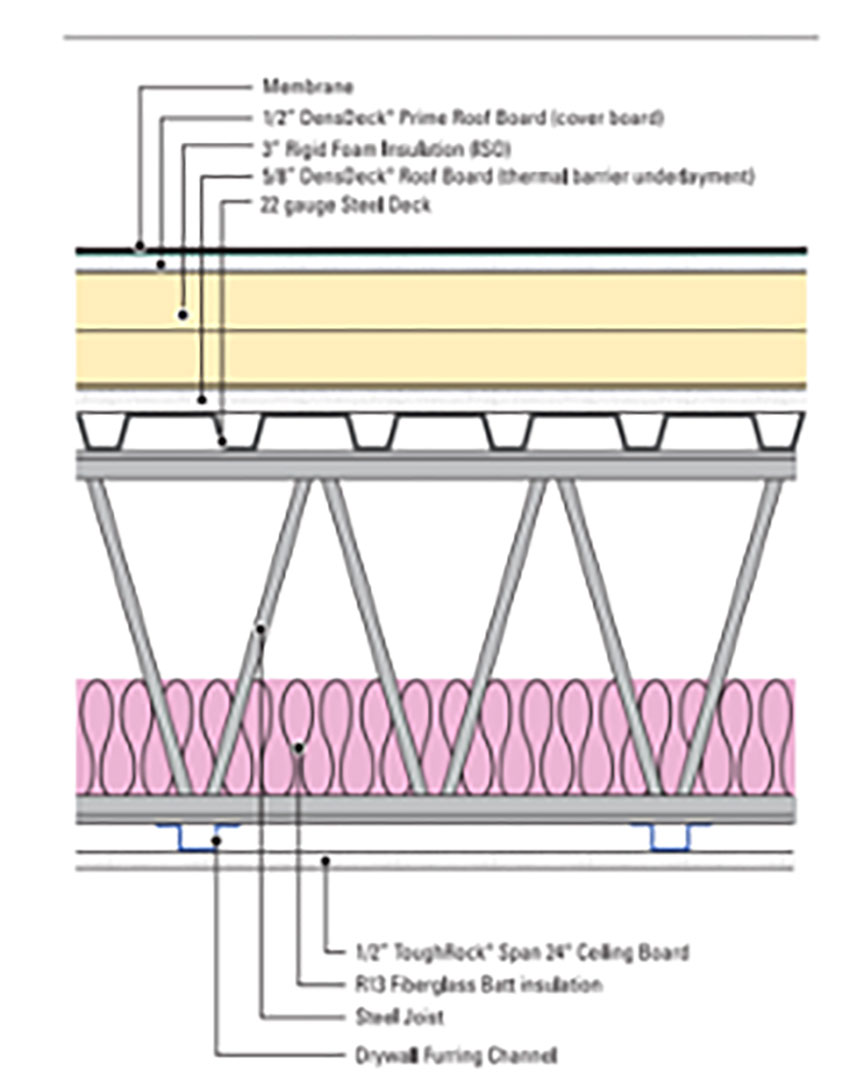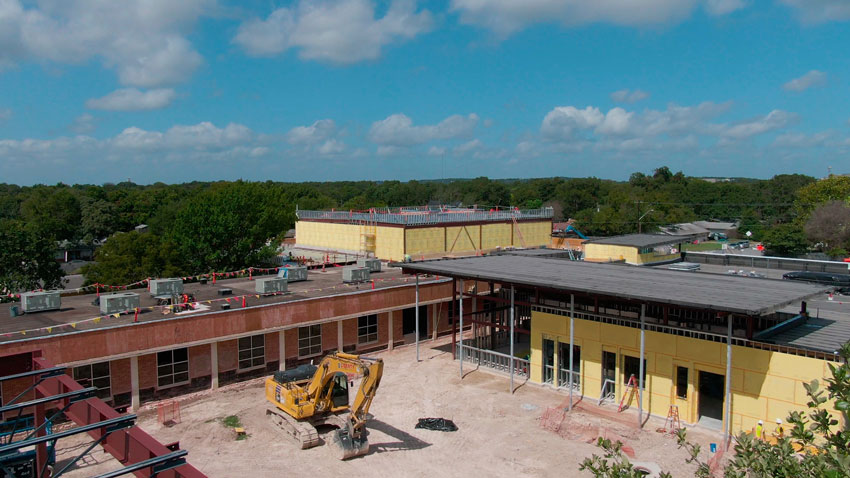
All photos courtesy of Georgia-Pacific Building Products
Brentwood Elementary School in Austin, Texas, gets a modern upgrade.
Designing educational buildings is a complex and multifaceted endeavor that presents architects with both significant challenges and unique opportunities. These structures are not merely spaces where learning occurs; they are environments that must cater to the diverse needs of students, staff, and the community at large. An educational building's design must ensure safety, health, and comfort while fostering an atmosphere conducive to learning and growth.

Architects must consider safety, health and comfort when designing for educational buildings.
The experience of occupying an educational building will greatly impact the knowledge the students take with them. A student’s ability to concentrate on the task at hand and to feel secure and comfortable are critical ingredients for their success. In this course, we will look at some of the challenges associated with educational buildings that impact the learning environment for students, staff, and visitors, and explore options available to support a well-designed and constructed space for learning.
THE UNIQUE CHALLENGESOF EDUCATIONAL BUILDINGS
Educational buildings are as diverse as the students who walk their halls. These structures range from preschools to colleges, vocational schools to biological laboratories, sports centers to libraries. Each building type has specific requirements based on size, location, and intended use. Designing such spaces involves more than assembling classrooms, laboratories, and offices. Architects must create environments that accommodate various activities, from focused individual study to collaborative group work. High schools, for example, often combine multiple functions, providing spaces for students, support areas for staff and gathering areas for community use. Educational buildings must cater to diverse user groups, including students, teachers, administrators, and the broader community, ensuring that the needs of each group are met effectively. While one design style does not fit all user groups, there are common themes and attributes that apply to educational buildings as a whole and effectively address most requirements.

Educational buildings serve diverse user groups and need to accommodate various activities including individual study and collaborative group work.
Noise Control
Managing and reducing the amount of noise in educational buildings is crucial for creating an optimal learning and working environment. For students, a quiet environment is essential for concentration and effective learning.
A study conducted by the Acoustical Society of America found that poor acoustics and high noise levels in classrooms are linked to decreased student performance. The research uncovered that in many classrooms in the United States, the speech intelligibility rating is 75 percent or less. In practical terms, this means that listeners with normal hearing can understand only 75 percent of the words spoken in the classroom. Research also demonstrated that noise impacts short-term memory and comprehension, with younger children being particularly vulnerable to these effects.1
In non-auditory tasks such as reading and writing, noise impairs students and their ability to learn, especially for children. Depending on the nature of the tasks and sounds, students encounter difficulties with perceptual and cognitive processes or have a shorter attention span and problems with focus. These issues result in lower test scores and increasingly create problems with disruptive behavior in the classroom. Data also suggests that over the long term, excessive and uncontrolled noise in the classroom may affect children’s cognitive development.2
Uncontrolled noise in educational settings can impact students of any age. A study published by the World Health Organization (WHO) and the European Commission's Joint Research Centre found that exposure to noise in college classroom settings can negatively affect cognitive tasks. The research further emphasized that older students with chronic exposure to noise, such as traffic or construction sounds, can lead to reduced attention spans and lower academic performance, as well as lower GPAs.3
Teachers and staff also suffer negative consequences when noise remains unchecked in educational buildings. The Journal of Speech, Language, and Hearing Research concludes that the vocal health of teachers was most negatively impacted by excessive noise. In quieter settings, teachers can deliver lessons without straining their voices, and students can hear and understand instructions more easily. This contributes to a more efficient teaching process and a healthier work environment for educators, reducing fatigue and improving job satisfaction.
A Safe Space
Safety is a paramount concern in educational building design, as the risks to students and staff come from many different areas. Fire is an ever-present concern, so educational buildings must comply with National Fire Protection Association (NFPA) standards, such as NFPA 101 (Life Safety Code) and NFPA 72 (National Fire Alarm and Signaling Code). These are crucial for fire safety in educational buildings and cover areas such as fire alarms, emergency lighting, exit routes, and fire-resistant materials to ensure schools can be safely evacuated during emergencies.
Safe learning environments take concerns like fire risk, emergency routes, visibility, surveillance, lockdown capabilities, indoor air quality, and resiliency into account.
Related to access and egress, architects should consider standards outlined by the U.S. Department of Homeland Security that emphasize the importance of physical security measures in schools. Building layout and design both play a significant role in ensuring security in educational settings. Layout and design should include planning for interiors with clear sightlines, unobstructed visibility of hallways and entrances to reduce hiding spots, and even the installation of safe rooms. Additionally, architects may need to include features such as surveillance systems, secure entry points, and lockdown capabilities to protect against potential threats.
A safe space must also be a healthy space, which is why creating a healthy indoor environment—especially focusing on indoor air quality (IAQ)—is crucial for successful learning.
Architects must design spaces with optimal air quality to enhance cognitive function and well-being. According to the U.S. Environmental Protection Agency (EPA), IAQ significantly influences students’ health, cognitive function, and overall academic performance.4 Poor air quality in schools can lead to respiratory issues, increased absenteeism, and reduced concentration and cognitive performance among students. This is because pollutants such as carbon dioxide, volatile organic compounds, and allergens can impair cognitive function and cause discomfort, negatively impacting learning outcomes. A large part of improving IAQ is to ensure the building envelope is designed, specified, and installed to prevent water migration, while also controlling air movement between the conditioned and unconditioned spaces of the structure.
Resiliency is another key attribute of educational buildings and is related to safety. Schools are often used outside of educational programming to serve as shelters and community meeting locations during times of regional crisis, such as power outages or storm events. Educational buildings are expected to be more durable and structurally sound than other buildings in the community. FEMA, the Federal Emergency Management Agency, has published a design guide specifically on improving school safety related to high-wind events, flooding, and earthquakes. The guide, FEMA P-424, encourages a performance-based design process rather than a prescriptive path toward implementation. The performance-based design process explicitly evaluates how building systems are likely to perform under a variety of conditions associated with potential hazards, like natural disasters.5
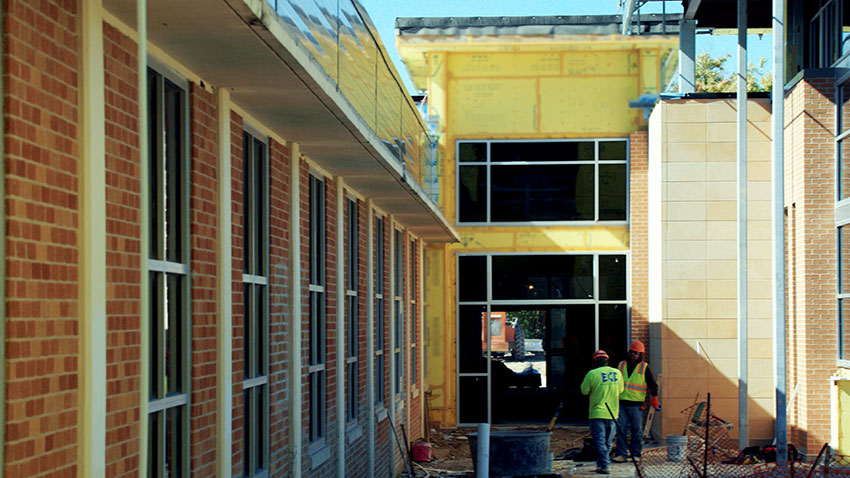
Durable buildings are designed to withstand wear and tear from high-volume use.

All photos courtesy of Georgia-Pacific Building Products
Brentwood Elementary School in Austin, Texas, gets a modern upgrade.
Designing educational buildings is a complex and multifaceted endeavor that presents architects with both significant challenges and unique opportunities. These structures are not merely spaces where learning occurs; they are environments that must cater to the diverse needs of students, staff, and the community at large. An educational building's design must ensure safety, health, and comfort while fostering an atmosphere conducive to learning and growth.

Architects must consider safety, health and comfort when designing for educational buildings.
The experience of occupying an educational building will greatly impact the knowledge the students take with them. A student’s ability to concentrate on the task at hand and to feel secure and comfortable are critical ingredients for their success. In this course, we will look at some of the challenges associated with educational buildings that impact the learning environment for students, staff, and visitors, and explore options available to support a well-designed and constructed space for learning.
THE UNIQUE CHALLENGESOF EDUCATIONAL BUILDINGS
Educational buildings are as diverse as the students who walk their halls. These structures range from preschools to colleges, vocational schools to biological laboratories, sports centers to libraries. Each building type has specific requirements based on size, location, and intended use. Designing such spaces involves more than assembling classrooms, laboratories, and offices. Architects must create environments that accommodate various activities, from focused individual study to collaborative group work. High schools, for example, often combine multiple functions, providing spaces for students, support areas for staff and gathering areas for community use. Educational buildings must cater to diverse user groups, including students, teachers, administrators, and the broader community, ensuring that the needs of each group are met effectively. While one design style does not fit all user groups, there are common themes and attributes that apply to educational buildings as a whole and effectively address most requirements.

Educational buildings serve diverse user groups and need to accommodate various activities including individual study and collaborative group work.
Noise Control
Managing and reducing the amount of noise in educational buildings is crucial for creating an optimal learning and working environment. For students, a quiet environment is essential for concentration and effective learning.
A study conducted by the Acoustical Society of America found that poor acoustics and high noise levels in classrooms are linked to decreased student performance. The research uncovered that in many classrooms in the United States, the speech intelligibility rating is 75 percent or less. In practical terms, this means that listeners with normal hearing can understand only 75 percent of the words spoken in the classroom. Research also demonstrated that noise impacts short-term memory and comprehension, with younger children being particularly vulnerable to these effects.1
In non-auditory tasks such as reading and writing, noise impairs students and their ability to learn, especially for children. Depending on the nature of the tasks and sounds, students encounter difficulties with perceptual and cognitive processes or have a shorter attention span and problems with focus. These issues result in lower test scores and increasingly create problems with disruptive behavior in the classroom. Data also suggests that over the long term, excessive and uncontrolled noise in the classroom may affect children’s cognitive development.2
Uncontrolled noise in educational settings can impact students of any age. A study published by the World Health Organization (WHO) and the European Commission's Joint Research Centre found that exposure to noise in college classroom settings can negatively affect cognitive tasks. The research further emphasized that older students with chronic exposure to noise, such as traffic or construction sounds, can lead to reduced attention spans and lower academic performance, as well as lower GPAs.3
Teachers and staff also suffer negative consequences when noise remains unchecked in educational buildings. The Journal of Speech, Language, and Hearing Research concludes that the vocal health of teachers was most negatively impacted by excessive noise. In quieter settings, teachers can deliver lessons without straining their voices, and students can hear and understand instructions more easily. This contributes to a more efficient teaching process and a healthier work environment for educators, reducing fatigue and improving job satisfaction.
A Safe Space
Safety is a paramount concern in educational building design, as the risks to students and staff come from many different areas. Fire is an ever-present concern, so educational buildings must comply with National Fire Protection Association (NFPA) standards, such as NFPA 101 (Life Safety Code) and NFPA 72 (National Fire Alarm and Signaling Code). These are crucial for fire safety in educational buildings and cover areas such as fire alarms, emergency lighting, exit routes, and fire-resistant materials to ensure schools can be safely evacuated during emergencies.
Safe learning environments take concerns like fire risk, emergency routes, visibility, surveillance, lockdown capabilities, indoor air quality, and resiliency into account.
Related to access and egress, architects should consider standards outlined by the U.S. Department of Homeland Security that emphasize the importance of physical security measures in schools. Building layout and design both play a significant role in ensuring security in educational settings. Layout and design should include planning for interiors with clear sightlines, unobstructed visibility of hallways and entrances to reduce hiding spots, and even the installation of safe rooms. Additionally, architects may need to include features such as surveillance systems, secure entry points, and lockdown capabilities to protect against potential threats.
A safe space must also be a healthy space, which is why creating a healthy indoor environment—especially focusing on indoor air quality (IAQ)—is crucial for successful learning.
Architects must design spaces with optimal air quality to enhance cognitive function and well-being. According to the U.S. Environmental Protection Agency (EPA), IAQ significantly influences students’ health, cognitive function, and overall academic performance.4 Poor air quality in schools can lead to respiratory issues, increased absenteeism, and reduced concentration and cognitive performance among students. This is because pollutants such as carbon dioxide, volatile organic compounds, and allergens can impair cognitive function and cause discomfort, negatively impacting learning outcomes. A large part of improving IAQ is to ensure the building envelope is designed, specified, and installed to prevent water migration, while also controlling air movement between the conditioned and unconditioned spaces of the structure.
Resiliency is another key attribute of educational buildings and is related to safety. Schools are often used outside of educational programming to serve as shelters and community meeting locations during times of regional crisis, such as power outages or storm events. Educational buildings are expected to be more durable and structurally sound than other buildings in the community. FEMA, the Federal Emergency Management Agency, has published a design guide specifically on improving school safety related to high-wind events, flooding, and earthquakes. The guide, FEMA P-424, encourages a performance-based design process rather than a prescriptive path toward implementation. The performance-based design process explicitly evaluates how building systems are likely to perform under a variety of conditions associated with potential hazards, like natural disasters.5

Durable buildings are designed to withstand wear and tear from high-volume use.
Built to Last
Another challenge that all educational buildings face is durability. How will the building perform over time? Schools, colleges, and universities are places of high-volume and constant use, often throughout the entire year. Every component of the building must be designed, specified, and constructed to withstand the constant wear and tear of students and staff while remaining functional, safe, and aesthetically appealing in all seasons.
High-traffic areas like entrances and exits contend with moisture issues when rain and snow are brought into the space on coats and shoes. For interiors, hallways and communal areas are prone to wall damage as educational equipment—consider the daily load and movement of audio/visual projectors, book carts, and mobile partitions—are moved from space to space. Overall, this combination of young people in large social groups has to accommodate activities and athletics that are unique to educational buildings but not as common in corporate, commercial, or retail spaces. Few CEOs engage in hacky sack—or indoor soccer—during lunch breaks.
On the exterior of educational buildings, the durability of rainscreens, siding, roofing materials, windows, and doors are all essential to maintain the integrity of the building envelope. This is where the design and specification of building materials and products become high priorities for architects and designers to ensure that the building remains safe and secure to protect students and staff.
The challenges of noise control, safety, and durability are a common connection between educational buildings of all sizes and types, but fortunately so is the set of potential solutions. Next, we will look at the opportunities architects have to design educational buildings and specify materials to address these issues.
OPPORTUNITIES IN EDUCATIONAL BUILDING DESIGN AND SPECIFICATIONS
Recognizing the specific challenges educational buildings face is the first step in resolving potential distractions and barriers to successful knowledge transfer to students. The next step is to identify design elements, building materials, and systems that can accomplish the goals of reducing uncontrolled noise, creating a safe space for students, and increasing the overall durability of the structure.
Creating a Sound Solution
Noise control within educational buildings should be managed to reduce uncontrolled sound generated on the exterior as well as the interior of the building. In the end, it does not matter where the noise comes from; it must be controlled and contained to acceptable levels before it enters and becomes detrimental to learning spaces.
On the exterior of the building, sound sources are numerous and often unpredictable. Designing an educational building based on current conditions may not provide adequate noise control for students in the future.
Traffic noise is one of the main distractions for students, and though patterns and volume of traffic may change during the day, the nearby presence of a street or highway will remain a constant challenge. Similarly, as educational buildings expand with development, nearby neighborhoods might grow with construction noise that can increase or decrease over time.
“Roofs play a critical role in the acoustic strategy of a building. They can be exposed to airborne sounds like airplanes and road traffic, as well as impact sounds like rain or maintenance crews,” notes Hamed Kayello, Product Manager at Georgia-Pacific. “Low slope roofs, especially if they’re metal and lightweight, should consider their desired acoustic performance during the design stage. Acoustic flat roof boards can help reduce the sound that transfers through a roofing assembly.”
According to Kayello, cover boards with a gypsum core work well because the cores help absorb and reduce noise. They can be installed in single or multiple layers depending on how much acoustic performance the project requires.
What may seem like a sleepy, quiet community today could develop into a place that encounters unexpected changes that create only more noise and barriers to learning.
One example of this is the Des Moines Elementary School in Des Moines, Washington. Located just a few miles south of Seattle, the original one-room school building was constructed in 1925 to provide education for the local community. At the time, the Puget Sound area was a hub of commerce, fishing, and timber, but starting in the early 1930s a new industry began to arise—aviation.
Home to the Boeing Company, the entire Seattle region soon became a flashpoint for designing, manufacturing, and testing planes and jets. The impact on Des Moines was significant, specifically when the original Boeing Field was built just a few miles from the coastal community. Boeing Field later became Seattle-Tacoma International Airport, or Sea-Tac, and today almost 1,200 aircraft depart or land there every day.
While once quaint and quiet, the Des Moines Elementary School found that it was located directly in the flight path of Sea-Tac. For the students and staff, the noise grew to become an ever-present aggravation.
In 2018, groundbreaking began on the site of the original schoolhouse to build a bigger, modern, and improved school for the children of Des Moines. Controlling noise was one of the top priorities for architects Hutteball + Oremus Architecture, who were tasked with the design of the new school.
To address the exterior noise issue, all the products specified for the building envelope, from sheathing to glazing to roof board, had to meet certain Sound Transmission Class (STC) ratings to comply with health department administrative code and Federal Aviation Administration (FAA) requirements.
Roofing systems are generally assessed for thermal insulation, waterproofing, and structural integrity, and have lower STC ratings at around 30-40 due to the lightweight and structural nature of roofing materials. For the Des Moines Elementary project, an STC rating of 49 was required, along with all the other requirements to protect the building from the heavy rainfall and frequent storms in the region.
To accomplish this, Hutteball + Oremus specified three layers of half-inch roof decking material selected for its sound control properties. The gypsum-core cover board had the unique feature of a fiberglass mat-faced covering instead of traditional paper, providing additional protection to both the board and the building.
To protect the new building interior, the district chose to install a temporary roof on the building during the construction process, with the first layer of cover board used as a base for a self-adhered waterproof underlayment. Its benefit was that it allowed the contractor to use the first layer of cover board for the permanent roof rather than having to install an additional cover board for the temporary roof. Skipping this step not only decreased material use, but also allowed the contractor to dry-in the temporary roof more quickly.
A similar gypsum core with fiberglass mat that also served as a water-resistive and air barrier was used on the exterior of the building, with an additional layer added for noise abatement. The extra layer provided mass to the wall, reducing the ability for sound vibrations to transfer to the interior, and allowing for a faster construction process and simpler installation for contractors.
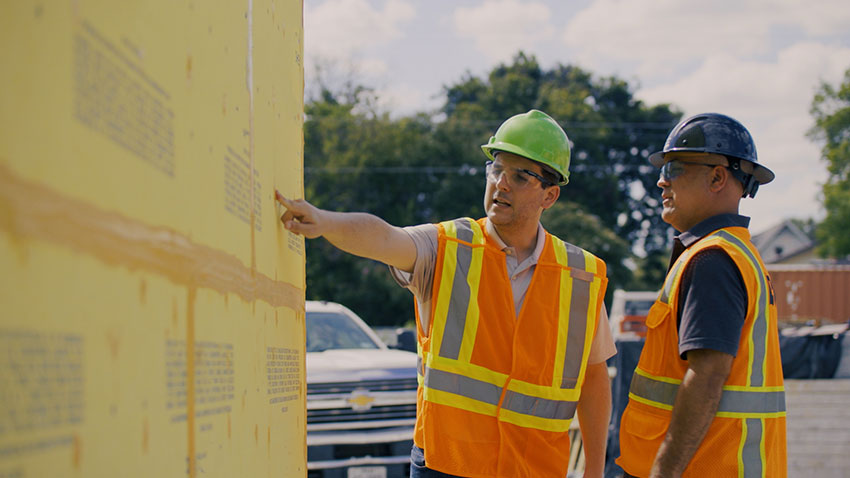
Specific building materials can enhance fire resistance and help with indoor air quality.
Design for Student Safety
As previously discussed, the safety of students and staff should always be at the forefront of any educational building design. For this course, we will take a closer look at how specification of building materials can enhance the safety of an educational building in the areas of fire and indoor air quality.
When evaluating building products and materials, there are many standards established specifically to address fire safety. For some commercial projects, simply adhering to the minimum expectations of code is adequate; however, for educational buildings, often the project will have enhanced requirements.
For the class of materials identified as strong candidates to address the challenges of designing and specifying for educational buildings, fiberglass-mat gypsum boards and related products perform well or above average in the previous standards. Gypsum boards are composed primarily of gypsum (calcium sulfate dihydrate), which is a naturally fire-resistant material. This composition inherently resists flame spread and smoke production. When combined with the inorganic and naturally fire-resistant fiberglass mat, boards of this type perform much better than those other materials for sheathing, roofing, and interior wall assemblies.
“Gypsum provides passive fire resistance,” says John Chamberlin, Senior Director of Product Management at Georgia-Pacific. “Every gypsum molecule has two water molecules in its chemical structure. Those water molecules will be released when exposed to a fire. This endothermic process helps delay the transmission of heat through the gypsum board. While the calcium sulfate dehydrates it continues to resist burning, forming an insulating layer to slow the spread of flames and heat.”
To evaluate building products and specify materials that will meet and exceed safety expectations, architects must have a strong working knowledge of the following industry-recognized fire standards.
UL Class A Fire Rating: A UL Class A fire rating is the highest classification given to materials for their ability to withstand severe fire exposure. This fire rating involves rigorous testing under standards set by Underwriters Laboratories (UL), including tests for flame spread, burn-through resistance, and structural integrity under fire conditions. Materials with a Class A rating are tested for their resistance to flame spread and their ability to resist severe fire exposure, as well as their capacity to prevent the spread of fire. To achieve a Class A rating, materials must score 0 - 25 for flame spread and 4 - 450 for smoke development. Materials that are better at maintaining structural integrity and slowing the spread of fire can provide extra time allows first responders more time to control fires, minimizing damage to the building.
ASTM C1177 (Fire Resistance): ASTM C1177 is a specification for glass-mat gypsum substrates used in the construction of fire-resistant wall assemblies. The standard outlines the requirements for the physical properties, performance characteristics, and testing procedures to ensure the material’s effectiveness in fire-rated assemblies. Products conforming to ASTM C1177 are evaluated for their fire resistance, moisture resistance, and overall durability, making them suitable for use in areas where both fire safety and long-term performance are critical.
UL 1256 (Under Roof Deck Fire Exposure): UL 1256 is a standard for fire tests of roof-deck constructions, specifically focusing on the resistance to fire from below the deck. The UL 1256 test simulates fire exposure from within the building, evaluating the roof deck’s ability to maintain its integrity and prevent fire penetration.
ASTM E84 (Flame/Smoke Developed): ASTM E84, also known as the “Standard Test Method for Surface Burning Characteristics of Building Materials,” measures the flame spread and smoke development of materials. This test is crucial for assessing the fire performance of interior finishes and insulation materials used in educational buildings. A low flame-spread index (FSI) and smoke-developed index (SDI) indicate that the material contributes minimally to fire spread and smoke production, enhancing the safety of the building’s interior environment. Materials with a score of 0/0 are considered exceptional in this standard classification. An FSI of 0 means that the material does not support flame propagation at all during the test and an SDI of 0 means that the material produces no measurable smoke during the test. In educational settings, slowing the spread of fire may provide more time for evacuation, and reduced smoke allows for greater visibility for occupants to escape.
UL723 (Roof Board Flame/Smoke Developed): UL 723, similar to ASTM E84, evaluates the surface burning characteristics of building materials, specifically roof boards in this context. For educational buildings, using roof boards with favorable UL 723 ratings may ensure that the roofing materials will not significantly contribute to the spread of fire or the production of harmful smoke. This is critical for maintaining the structural integrity of the building in the event of a fire.
ULC CANS102 (Roof Board Flame/Smoke Developed): ULC CAN-S102 is a Canadian standard akin to ASTM E84 and UL 723, focusing on the flame spread and smoke development of building materials, particularly roof boards. By adhering to ULC CAN-S102, architects can select roof boards that minimize fire spread and smoke production. The standard provides a clear benchmark for material performance, aiding in the design of buildings that are both safe and compliant with Canadian fire safety regulations.
ASTM E136 or CAN/ULC S114 (Interior Panel Combustibility): ASTM E136 and CAN/ULC S114 are standards for testing the non-combustibility of materials. These standards are crucial for ensuring that interior panels used in educational buildings do not contribute to fire spread. ASTM E136 is a widely recognized standard in the United States, while CAN/ULC S114 is its Canadian counterpart. Both tests involve subjecting materials to high temperatures and observing their combustion characteristics. Materials that pass these tests are considered non-combustible and suitable for use in fire-resistant construction.
ASTM C1396: ASTM C1396 focuses on the specifications and performance of gypsum boards used in construction, including regular gypsum board, gypsum sheathing board, water-resistant gypsum backing board, and gypsum core board. The standard specifies the requirements for the physical properties, performance characteristics, and testing methods for these materials. One of the key aspects of ASTM C1396 is the focus on fire resistance. Gypsum boards conforming to this standard must meet stringent fire-performance criteria, making them suitable for use in fire-rated assemblies. Materials that achieve a “Type X” classification are noted as having increased fire resistance beyond regular gypsum panels.
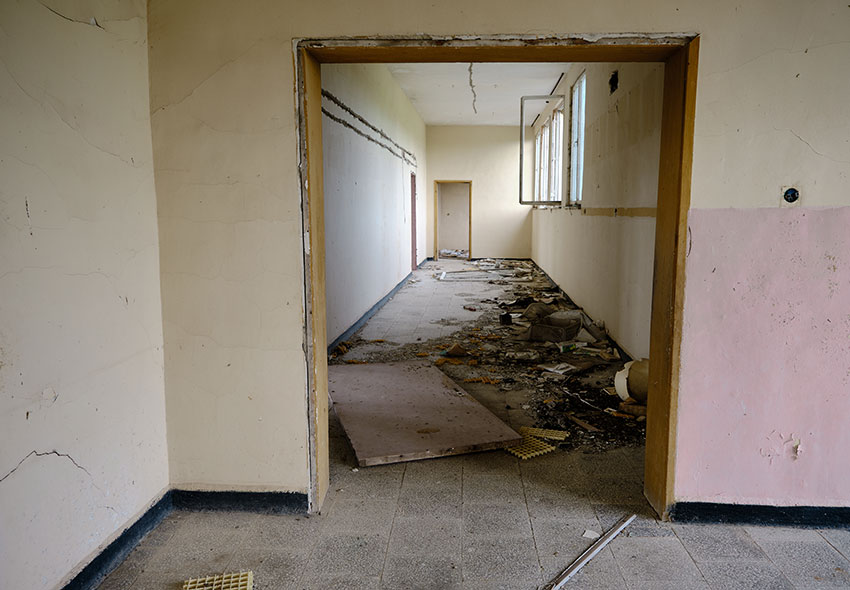
Severe damage to educational facilities can expose allergens, mold, mildew, and bacteria.
Shifting focus from fire to water, the other safety concern we will discuss is the need to create healthy IAQ for educational buildings. As stated previously, poor IAQ can impact not only the physical well-being of students and staff but also increase sick days and impair the ability of students to learn.
There are many contributors to poor IAQ in educational buildings. Aging HVAC systems that do not provide adequate filtration or appropriate air changes per hour can create stagnant spaces that students are stuck in for long periods of time. Allergens and pollutants, as well as volatile organic compounds (VOCs), are often introduced into educational settings as students, teachers, and staff go about the normal tasks of coming and going from school. While the architect has little control over the operational habits of the occupants, there are specific risks that the designer can address to help improve IAQ over the duration of the life of the building, such as water migration into the conditioned space.
Water poses many challenges to buildings but in terms of IAQ, the main risk is the development of mold, mildew, and bacteria. Mold and mildew are both fungi that thrive in damp environments and require organic materials for sustenance. They differ in appearance, but both have a negative impact on IAQ. Bacteria is a surface dweller too small to be observed but can trigger allergic reactions and exacerbate asthma, particularly affecting sensitive individuals and those with preexisting conditions.
Mold typically appears as black, green, or blue patches and can grow on various surfaces like walls, ceilings, and furniture. Mold releases spores into the air, which can trigger allergies, asthma, and other respiratory issues. Certain molds, like Stachybotrys chartarum (black mold), produce mycotoxins, posing significant health risks.
Mildew is usually white or gray and appears as a powdery or fluffy growth and specifically targets organic materials like paper, leather, cloth, and the organic matter on surfaces such as bathroom tiles, windowsills, and shower curtains. While generally less harmful than mold, mildew can still cause respiratory problems and allergic reactions, especially in sensitive individuals.
Bacteria require water to thrive because it is essential for their metabolic processes, nutrient absorption, and reproduction. In the presence of moisture, bacteria can rapidly multiply, particularly in environments with organic matter that serves as a food source. Bacteria can become airborne, forming bioaerosols that circulate through the building’s HVAC system. These bioaerosols can be inhaled by occupants, leading to respiratory issues, infections, and allergic reactions. Damp areas in educational buildings, such as water leaks through the building envelope, wet surfaces, and poorly ventilated spaces, can become breeding grounds for bacterial growth.
As with fire safety, there are standards architects can use to determine how effective a building material or product will be at reducing the proliferation of mold, mildew, and bacteria in educational settings.“Actual job site conditions always vary,” notes Chamberlin, “You can’t always be sure that a product’s mold resistance will produce the same results that were achieved in a controlled, laboratory setting. However, when used properly, fiberglass-mat gypsum panels can provide increased mold and moisture resistance compared to standard paper-faced boards.”
ASTM D3273 (Interior Panel Mold Resistance): ASTM D3273 is a standard test method for evaluating the resistance of interior panels to mold growth. The test involves exposing panels to high humidity and temperature conditions conducive to mold growth and assessing their resistance over time. Materials that perform well under ASTM D3273 testing may help prevent mold-related issues, which may lead to a safer and healthier learning environment. Architects use this standard to select interior panels that contribute to the longevity and healthiness of educational facilities.
ASTM D6329-98 (Microbial Resistance): ASTM D6329-98 is a standard guide for developing methodologies to evaluate the microbial resistance of materials. The guide provides procedures for assessing the resistance of materials to mold, bacteria, and other microorganisms. By using materials tested to ASTM D6329-98, architects can design buildings that are more resistant to microbial growth, thereby potentially enhancing the durability and healthiness of educational environments.
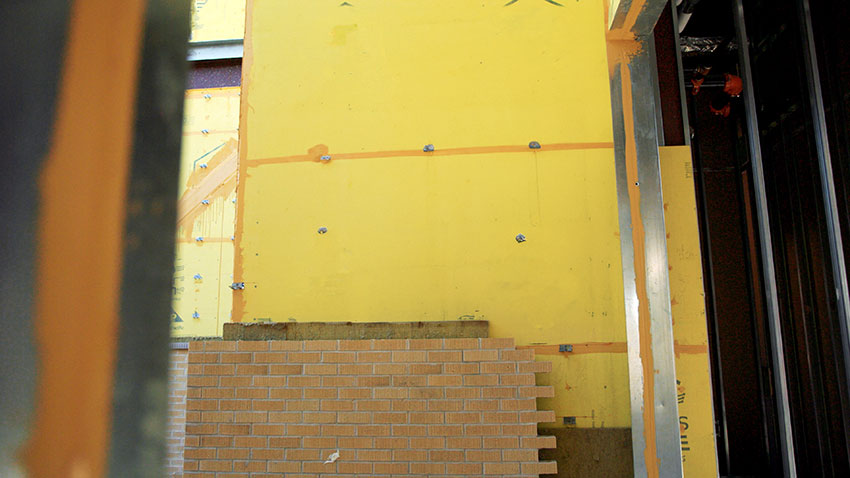
A successful water-resistive barrier is installed between the cladding and interior framing on the face of the sheathing or similar surface. Any gaps are properly sealed, so it stays continuous and intact.
DURABILITY IN THE DETAILS
Durability in educational buildings is the final consideration we will explore in this course. The goal is to design and specify spaces that will perform as intended over time, withstand the abuse from within (occupants) and without (environmental), and maintain aesthetic appeal and functionality. There are two key areas in educational buildings that require special attention to ensure the durability of the structure: water-resistive barriers (WRBs) and air barriers (ABs) on the exterior, and high-traffic flooring on the interior.
Starting with the exterior, the main function of the WRB is to help protect the wall assembly from bulk liquid water introduced from the exterior and direct it down and away from the building. The WRB is installed between the cladding and interior framing on the face of the sheathing or similar surface. The key to a successful WRB is that it is continuous and intact, meaning any gaps or penetrations are properly sealed.
An effective air barrier is also critical for the performance, health, and durability of educational buildings. A tight building envelope with a well-sealed air barrier can greatly improve energy efficiency, improve comfort, and promote IAQ goals. Modern air barriers must also effectively manage water vapor while maintaining the right level of permeability to ensure wall assemblies can dry. These barriers are designed not only to prevent air leakage but also to balance moisture control by allowing water vapor to escape from the interior spaces to the exterior. In educational settings, water vapor can be generated from cooking in the kitchens, showers in the gymnasium, or simply by occupants breathing. Removing this moisture is critical in preventing condensation and potential saturation within wall cavities, which can lead to mold growth, insulation and material degradation, and compromised indoor air quality. By allowing controlled vapor permeability, modern air barriers help maintain the structural integrity of the building envelope, ensuring that walls can dry out when exposed to moisture from either indoor activities or external weather conditions. This balance is essential in creating a healthy, long-lasting environment that supports the well-being of students and staff in educational settings.
Referring to the solution set we discussed earlier in the course, gypsum fiberglass-mat exterior boards can offer both a WRB and AB while also being the exterior sheathing option. Modern manufacturers of fiberglass-mat exterior sheathing have introduced products with proprietary formulations that integrate the gypsum core and the fiberglass mat to form a hydrophobic, monolithic surface that blocks bulk water but allows vapor to pass through. By retaining high permeability, these exterior boards enable moisture to pass through the wall in both directions in any climate. The benefit for educational buildings is that the sheathing allows wall assemblies to dry out if they get wet, helping to avoid mildew, mold, and deterioration.
Because of their inherently robust nature, gypsum fiberglass-mat exterior boards are resistant to delamination and deterioration due to weather exposure—even during construction delays that last as long as twelve months after installation. The ability to maintain integrity during delays or inclement weather on the jobsite helps ensure that the product will perform as expected when the final cladding is installed.
The other area where durability within the educational building can become a problem is any high-traffic area where water is a concern.
“What’s been interesting for us is to see where products like an integrated WRB sheathing system can help solve problems. Compression of construction timing, where schedule is important, especially if the project is happening in an area with a very small window in terms of weather or in certain conditions like high winds or the possibility of freezing rain,” says Chamberlain. That’s when you need to know you can get the system up quickly and trust that it’s intact without having concerns about appropriate curing times or if the structure will be dried in before a big storm comes. That’s when the flexibility around an integrated WRB sheathing system really comes into play.”
Educational buildings often have areas subject to high levels of moisture, such as bathrooms, locker rooms, kitchens, and science laboratories. In these spaces, moisture management is critical to prevent the growth of mold and mildew. Again, looking at fiberglass mat gypsum boards as an alternative to traditional materials, we find several benefits. Non-cement board backer boards are engineered to resist moisture absorption while providing a stable base for tile and other finishes. Unlike cement boards, which can be prone to water absorption and degradation over time, non-cement boards may maintain their structural integrity even in damp conditions. This moisture resistance helps prevent warping, swelling, and other forms of damage that can occur with prolonged exposure to moisture, which may help to ensure the subfloor remains durable and reliable.
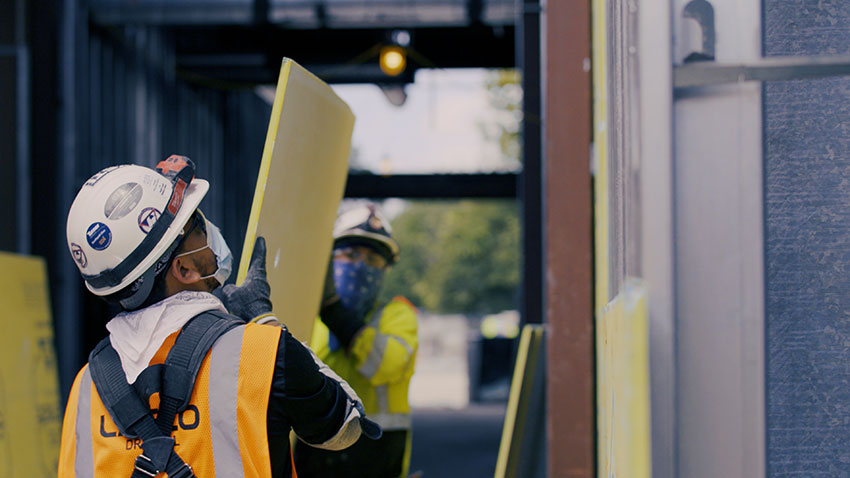
Fiberglass-mat gypsum boards are typically lighter and easier to cut than cement boards, reducing labor costs and speeding up installation.
As a bonus, installation of gypsum fiberglass-mat board is easier and faster than cement board backer installation. These boards are typically lighter and easier to cut than cement boards, reducing labor costs and speeding up the installation process. Moreover, they can be installed over a variety of subfloor types, including wood and concrete, providing architects with greater flexibility in design and material selection. Whether in high-moisture areas or high-traffic zones, these boards provide a reliable foundation that supports both the performance and longevity of the flooring system.
CONCLUSION
In conclusion, the design of educational buildings requires a thoughtful blend of innovative materials and strategic planning to overcome the unique challenges they present. By prioritizing noise control, safety, and durability, and leveraging modern solutions such as fiberglass-mat gypsum boards, architects can ensure that these buildings provide a conducive, safe, and resilient environment for students to learn. This comprehensive approach ultimately supports the mission of educational institutions to foster learning and growth in a supportive and sustainable setting.
SOURCES
https://acousticalsociety.org/wp-content/uploads/2022/01/Classroom-Acoustics.pdf.
https://www.ncbi.nlm.nih.gov/pmc/articles/PMC3757288/.
https://www.ncbi.nlm.nih.gov/pmc/articles/PMC5965003/.
https://www.epa.gov/iaq-schools/why-indoor-air-quality-important-schools.
https://www.fema.gov/sites/default/files/documents/fema_p-424-design-guide-improving-school-safety.pdf.
Andrew A. Hunt is Vice President of Confluence Communications and specializes in writing, design, and production of articles and presentations related to sustainable design in the built environment. In addition to instructional design, writing, and project management, Andrew is an accomplished musician and voice over actor, providing score and narration for both the entertainment and education arena. www.confluencec.com, www.linkedin.com/in/andrew-a-hunt-91b747.



